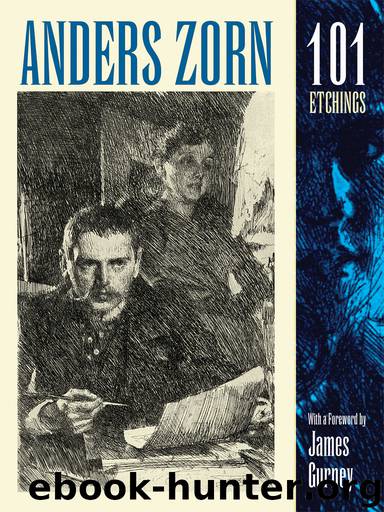Anders Zorn 101 Etchings by James Gurney

Author:James Gurney
Language: eng
Format: epub
Publisher: Dover Publications, Inc.
Published: 2018-12-15T16:00:00+00:00
Notes on the Etchings
The ideal of etching is to tell much in as few lines as possible; to appeal by suggestion more than by detailed delineation. Ruskin did not understand etching and called it the “art of scratch,” and so it may be to the mere dilettante, but in the works of the great masters every line is flowing, live and free. The ease with which the needle can be made to express the artist’s will upon the wax-covered copper plate gives the etching, unlike the more formal and laboriously executed engraving, a spontaneity and freedom similar to that of the sketch. “If you cannot sketch, you cannot etch,” wrote P.J. Hamerton. Etching is therefore one of the most suitable processes for expressing an evanescent vision or a sudden momentary impression which might be of as great value artistically as a slowly and elaborately conceived composition.
Etching has always been considered an art essentially feminine and delicate, but Zorn’s work is stamped with his own personality—virile and vibrant with life. He etched in a broad manner, and his bold, coarse lines seem to have been slashed into the copper in a moment of passionate concentration. His first etchings, which he began to make in London in 1883, were all copies from his water-colors, and he showed a skillful technique from the very beginning. His real strength as an etcher, however, did not appear until after 1888, when he had abandoned water-colors for the more vigorous painting in oil. Then he reached his full maturity, and in the next five years astonished the world of art with a series of wonderful etchings culminating in his My Model and My Boat of 1894.
Rosita Mauri (Plate 4) is a unique experiment in illumination. The dancer is standing in a doorway and seems to be hesitating before entering the room from which the light streams upon her face and flickers on the folds of her clothes. In the dim illumination she is partly indistinguishable from her shadow and a suggestion of the footlights is evoked in an almost indefinable way.
Un Première (Plate 5) is the first of Zorn’s many representations of the nude in the open air. It is a version of the same theme which he expressed in water-colors and in oils, and is considered one of his most happy inspirations. The mother and child are etched against the background and gently lapping waves. The outlines of their bodies are merely suggested, and a tenderness and softness of effect is obtained that is frequently absent in his later and more vigorously modelled nudes.
In his next great etching, the self portrait with his wife (Plate 6), Zorn has again treated the problem in interior lighting with great skill. The lamp shed an uneven light through the room, emphasizing the high spots and focusing our attention upon the all-important etching needle which is at rest in the artist’s hand for a moment while he looks searchingly into his own penetrating eyes reflected in the mirror before him.
Download
This site does not store any files on its server. We only index and link to content provided by other sites. Please contact the content providers to delete copyright contents if any and email us, we'll remove relevant links or contents immediately.
You & Me & Why We Are in Love by Aurelia Alcaïs(3179)
The Four Agreements: A Practical Guide to Personal Freedom (A Toltec Wisdom Book) by Ruiz Don Miguel(2431)
7-14 Days by Noah Waters(2358)
Things Are What You Make of Them: Life Advice for Creatives by Adam J. Kurtz(1816)
Wall and Piece by Banksy(1778)
Post-Impressionism by Nathalia Brodskaya(1670)
Hieronymus Bosch by Virginia Pitts Rembert(1628)
The Thibaults by Roger Martin Du Gard(1571)
The Notebooks of Leonardo Da Vinci by Da Vinci Leonardo(1564)
The Andy Warhol Diaries by Andy Warhol(1559)
Design as Art by Bruno Munari(1549)
The Andy Warhol Diaries by Andy Warhol & Pat Hackett(1510)
Picasso by Gertrude Stein(1502)
Modeling the Head in Clay by Bruno Lucchesi(1477)
Delphi Complete Works of Vincent van Gogh by Vincent van Gogh(1447)
Memory's Wake by Fenech Selina(1440)
Delphi Complete Works of Artemisia Gentileschi (Illustrated) by Artemisia Gentileschi(1434)
Auguste Rodin by Rainer Maria Rilke(1362)
South by Ernest Henry Shackleton(1355)
